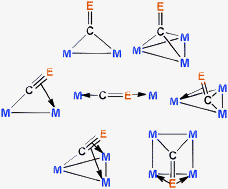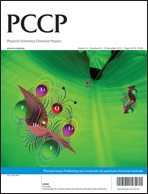The chemistry of metal thiocarbonyls is much more limited than that of metal carbonyls because of the instability of CS as a synthetic reagent. In view of the many gaps remaining in experimentally realized metal thiocarbonyl chemistry, theoretical studies using density functional methods have been used to explore the possible future scope of metal thiocarbonyl chemistry. This paper reviews such theoretical studies on binuclear metal carbonyl derivatives of the types M2(CS)2(CO)n and Cp2M2(CS)2(CO)n (Cp = η5-C5H5; M = V through Ni) as well as the trinuclear and tetranuclear iron carbonyls Fe3(CS)3(CO)n (n = 9, 8, 7, 6) and Fe4(CS)4(CO)n (n = 12, 11, 10, 9). The substitution of one or two CO groups with CS groups to give less symmetrical structures leads to many more isomers. Structures in which a four-electron donor thiocarbonyl group uses its sulfur atom to bridge a metal–metal bond as a η2-μ-CS ligand are more favorable in binuclear metal thiocarbonyl chemistry than corresponding structures in metal carbonyl chemistry owing to the basicity of the sulfur atom. Six-electron donor thiocarbonyl groups bridging clusters of three or four iron atoms are also found in low-energy structures including a particularly favorable Fe4(CS)4(CO)10 structure suggested as a possible target for future synthetic chemistry. In thiocarbonyl substitution products of simple binuclear metal carbonyls such as Fe2(CO)9 [= Fe2(CO)6(μ-CO)3], Co2(CO)8 [= Co2(CO)6(μ-CO)2], and Cp2Fe2(CO)4 [= Cp2Fe2(CO)2(μ-CO)2], structures with bridging CS groups are invariably lower energy structures than isomeric structures with bridging CO groups.

You have access to this article
 Please wait while we load your content...
Something went wrong. Try again?
Please wait while we load your content...
Something went wrong. Try again?


 Please wait while we load your content...
Please wait while we load your content...